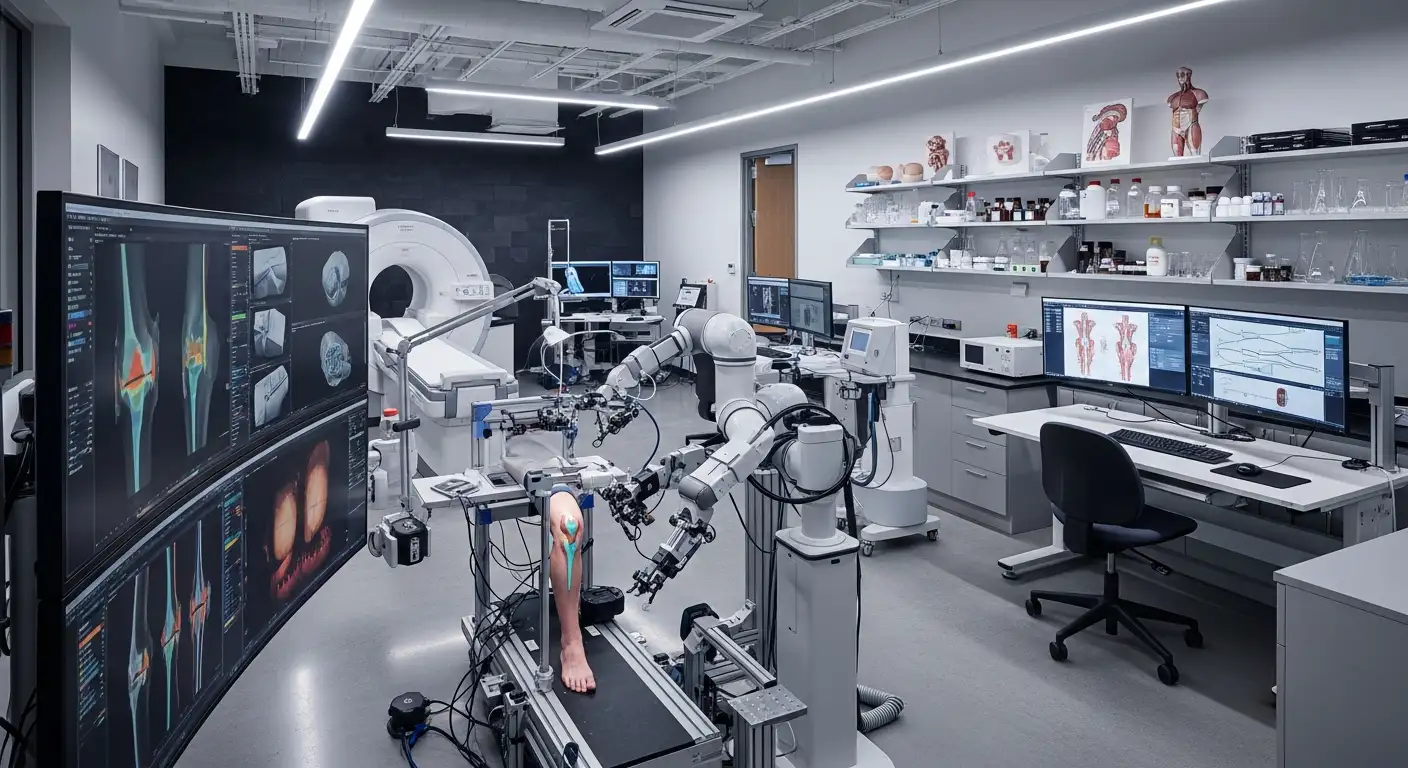Understanding Meniscus Tears
When it comes to knee injuries, a shredded meniscus is a common concern. Understanding the causes, risk factors, and symptoms associated with meniscus tears is essential for proper diagnosis and treatment.

Causes and Risk Factors
A torn meniscus can occur due to various activities that forcefully twist or rotate the knee, especially when putting full weight on it [1]. Some common causes of meniscus tears include:
- Sudden twisting or pivoting movements of the knee, often seen in sports activities like football or basketball.
- Direct impact or trauma to the knee, such as a fall or collision.
- Age-related wear and tear on the knees, leading to degenerative changes in the meniscus.
- Repetitive movements and prolonged weight-bearing activities, especially in older individuals [2].
Certain risk factors increase the likelihood of experiencing a meniscus tear. These include:
- Participating in activities that involve aggressive twisting and pivoting of the knee.
- Engaging in contact sports, where the knee is subjected to direct blows or sudden changes in direction.
- Age-related factors, as the meniscus becomes more prone to tearing due to natural degeneration [1].
- In older adults, even minimal trauma can cause a meniscus tear due to degenerative changes in the knee joint.
Symptoms and Diagnosis
The symptoms of a meniscus tear can vary depending on the severity of the injury. Common signs and symptoms include:
- Pain, especially when twisting or rotating the knee.
- Swelling and stiffness in the knee joint.
- A popping or clicking sensation at the time of injury.
- Difficulty fully extending or flexing the knee.
- Feeling of instability or giving way in the knee [3].
If a meniscus tear is suspected, a proper diagnosis is crucial for determining the appropriate treatment plan. A healthcare professional will typically perform a thorough physical examination of the knee, assessing range of motion, stability, and signs of injury. Imaging tests, such as an MRI or X-ray, may be ordered to confirm the diagnosis and evaluate the extent of the tear.
It's important to seek medical attention if you experience symptoms of a meniscus tear. Only a healthcare professional can provide an accurate diagnosis and recommend the most suitable treatment options for your specific situation.
In the next sections, we will discuss the treatment options available for meniscus tears, including both conservative management and surgical interventions. Stay tuned to learn more about how to navigate the path to recovery after a meniscus tear.
Treatment Options for Meniscus Tears
When it comes to treating a shredded meniscus, there are two main approaches: conservative management and surgical interventions. The choice of treatment depends on various factors, including the severity and location of the tear.

Conservative Management
In some cases, conservative treatment methods may be sufficient to relieve the pain and improve the function of a torn meniscus. This approach involves non-surgical options and focuses on reducing symptoms and promoting healing. Common conservative management strategies include:
- Resting the knee and avoiding activities that may aggravate the tear.
- Applying ice packs to the affected area to reduce swelling and pain.
- Taking over-the-counter pain medications, such as acetaminophen or nonsteroidal anti-inflammatory drugs (NSAIDs), to alleviate pain and inflammation.
- Using crutches to limit strain, twisting, and bending of the knee.
- Engaging in physical therapy, which may include exercises to strengthen the muscles around the knee, improve stability, and promote healing.
Conservative management is often recommended for smaller tears or tears associated with arthritis. It is important to work closely with a healthcare professional to develop an individualized treatment plan based on the specific characteristics of the tear.
Surgical Interventions
In cases where conservative management fails to provide adequate relief or for more severe tears, surgical intervention may be necessary. Surgery aims to repair or remove the damaged meniscus, depending on the tear's location, pattern, and the overall condition of the meniscus.
The surgical procedures commonly performed for meniscus tears include:
- Partial meniscectomy: This procedure involves the removal of the torn portion of the meniscus. It is often performed arthroscopically, using small incisions and a specialized camera called an arthroscope to guide the surgeon.
- Meniscus repair: In some cases, a torn meniscus can be repaired by suturing the torn edges together. This procedure is usually recommended for tears that occur in the outer region of the meniscus, where there is a good blood supply to support healing.
- Meniscus transplant: In rare cases, when a significant portion of the meniscus is damaged or removed, a meniscus transplant may be considered. This procedure involves replacing the damaged meniscus with a donor meniscus or a synthetic implant.
The choice of surgical intervention depends on multiple factors, including the type and severity of the tear, the patient's age, and overall knee health. It is important to consult with an orthopedic specialist to determine the most appropriate surgical approach for a shredded meniscus.
Both conservative management and surgical interventions have their respective benefits and considerations. The decision regarding the best treatment option should be made in collaboration with a healthcare professional, taking into account the individual's specific circumstances and goals for recovery. For information on recovery after meniscus surgery, refer to the section on post-surgery guidelines and rehabilitation and physical therapy.
Recovery Process After Meniscus Surgery
After undergoing meniscus surgery, it is important to follow a structured recovery process to optimize healing and regain full functionality of the knee. This section will outline the post-surgery guidelines and the role of rehabilitation and physical therapy in the recovery process.
Post-Surgery Guidelines
Following meniscus surgery, the immediate post-surgery guidelines are essential for a successful recovery. While the exact guidelines may vary depending on the type of surgery performed and the individual's condition, there are some general principles to keep in mind.
- Weight-bearing: The ability to bear weight on the affected knee will depend on the type of surgery performed. For uncomplicated meniscectomy surgery, weight-bearing is typically allowed right away. However, for meniscus repair surgery, it may take 0 to 6 weeks before bearing weight on the knee is possible.
- Crutches: The use of crutches may be necessary during the initial stages of recovery, especially after meniscus repair surgery. Walking without crutches can be achieved in 2 to 7 days after uncomplicated meniscectomy, compared to 4 to 6 weeks after meniscus repair surgery.
- Range of motion: Regaining full range of motion is an important goal of the recovery process. After surgery, physical therapy exercises and stretching will be prescribed to gradually improve knee flexibility. Typically, full range of motion can be achieved within 1 to 2 weeks post-surgery, with motion being restricted for the first 4 to 6 weeks to allow the meniscus to heal [4].
- Driving: The ability to resume driving will depend on the type of surgery performed and the affected leg's involvement in operating the vehicle. For uncomplicated meniscectomy, driving can generally be resumed 1 to 2 weeks after surgery if the affected leg is used for gas and brake. However, after meniscus repair surgery, it may take 4 to 6 weeks before driving can be safely resumed [4].
- Return to work and sports: The timeline for returning to work or sports will also depend on the type of surgery and the individual's progress. Returning to heavy work or sports can take 4 to 6 weeks after uncomplicated meniscectomy, whereas it may take 3 to 6 months after meniscus repair surgery. It is crucial to follow the guidance of the healthcare provider and gradually increase activity levels to avoid re-injury [4].

Rehabilitation and Physical Therapy
Rehabilitation and physical therapy play a critical role in the recovery process after meniscus surgery. These interventions focus on restoring strength, flexibility, and function to the knee. A customized rehabilitation program will be developed by a physical therapist based on the individual's specific needs and the type of surgery performed.
The goals of rehabilitation and physical therapy after meniscus surgery include:
- Strengthening: Targeted exercises will be prescribed to strengthen the muscles surrounding the knee joint. This helps provide stability and support to the knee, reducing the risk of future injuries.
- Range of motion: Through stretching exercises and gentle movements, physical therapy aims to improve and maintain the full range of motion of the knee joint.
- Balance and proprioception: Exercises that challenge balance and proprioception are incorporated to improve coordination and reduce the risk of falls or instability.
- Functional training: Rehabilitation programs often include activities that mimic daily tasks or sports-specific movements to ensure a safe return to regular activities or sports.
- Pain management: Physical therapists may use various modalities such as ice, heat, or electrical stimulation to manage pain and reduce inflammation during the recovery process.
It is important to adhere to the prescribed rehabilitation program, attend all scheduled physical therapy sessions, and communicate any concerns or difficulties experienced during the recovery process. The guidance and expertise of a physical therapist can greatly contribute to a successful recovery and help individuals regain optimal function of the knee.
By following the post-surgery guidelines and actively participating in rehabilitation and physical therapy, individuals can enhance their recovery process and improve their chances of returning to their normal activities or sports as soon as possible.
Meniscus Tear Healing Time
When it comes to a shredded meniscus, understanding the healing time is essential for individuals seeking recovery. The healing duration can vary depending on several factors, including the treatment approach and the severity of the tear. Let's explore the factors affecting recovery and the expected healing duration.
Factors Affecting Recovery
Several factors can influence the recovery process for a meniscus tear. These factors include:
- Type of Treatment: The chosen treatment approach, whether conservative management or surgical intervention, can impact the healing time. Conservative management, which includes rest, physical therapy, and other non-invasive methods, may have a shorter recovery time compared to surgical procedures [5].
- Severity and Position of the Tear: The severity and location of the meniscus tear also play a role in the healing process. Minor tears or tears in the outer edges of the meniscus may heal more quickly than larger or complex tears.
- Patient's Age and Overall Knee Health: Younger individuals generally have better healing capabilities, while older individuals may experience a longer healing duration. Additionally, the overall health of the knee, including the presence of other bone or joint issues, can affect the healing process [2].
Expected Healing Duration
The healing time for a meniscus tear can vary depending on the treatment approach and the individual's condition. Here is an overview of the approximate healing durations:
- Meniscus Tear Without Surgery: For minor tears that can be managed conservatively, the healing time can range from four to eight weeks [2]. However, it's important to note that the healing process may be longer for more severe tears or tears in certain areas of the meniscus.
- Meniscectomy Recovery Time: Meniscectomy is a surgical procedure where a portion of the damaged meniscus is removed. After uncomplicated meniscectomy, individuals may be allowed to bear weight on the knee right away, and the recovery time is typically around three to six weeks [4].
- Meniscus Repair Recovery Time: Meniscus repair surgery involves suturing the torn meniscus back together. The recovery time for meniscus repair is longer compared to meniscectomy. It may take approximately three to six months for individuals to fully recover and return to regular activities.
It's important to keep in mind that these are approximate healing durations, and individual experiences may vary. It's always best to consult with a healthcare professional to get an accurate assessment of your specific case and expected recovery time.
During the recovery process, following post-surgery guidelines, engaging in rehabilitation and physical therapy, and maintaining knee health are crucial for optimal healing and regaining full functionality. For more information on the recovery process after meniscus surgery, refer to our article on recovery process after meniscus surgery.
Prevention and Lifestyle Considerations
When it comes to a shredded meniscus, prevention and lifestyle considerations play a crucial role in managing the condition and reducing the risk of further damage. By avoiding activities that aggravate tears and maintaining knee health, individuals can help protect their meniscus and promote overall knee well-being.
Avoiding Activities that Aggravate Tears
To prevent aggravating a torn meniscus, it is essential to avoid activities that put excessive stress on the knee joint. Some activities that should be avoided include:
- Aggressive twisting or rotating of the knee
- Direct contact on the side of the knee
- Landing roughly on the feet after a jump
- Kneeling for prolonged periods
- Performing deep squats
- Sudden stops or turns
- Bearing heavy weights
Engaging in these activities can further damage the torn meniscus and prolong the healing process. It is important to listen to your body and avoid any movements or actions that cause pain or discomfort. If you are unsure about specific activities to avoid, consult with a healthcare professional or knee specialist for personalized guidance.
Maintaining Knee Health
In addition to avoiding activities that aggravate meniscus tears, maintaining overall knee health is paramount. Here are some tips to promote knee well-being:
- Strengthening the muscles around the knee: Engaging in regular exercises that target the muscles around the knee, such as the quadriceps and hamstrings, can help provide added support and stability to the knee joint. Consult with a physical therapist or fitness professional for a tailored exercise program.
- Maintaining a healthy weight: Excessive weight can place added stress on the knee joint, increasing the risk of meniscus tears. Maintaining a healthy weight through a balanced diet and regular exercise can help alleviate stress on the knee and reduce the likelihood of injury.
- Using proper form and technique during physical activities: Whether participating in sports or performing daily activities, it is important to use proper form and technique to minimize the risk of knee injuries. This includes using appropriate footwear, warming up before physical activity, and avoiding sudden, jerky movements.
- Listening to your body: Pay attention to any pain, discomfort, or swelling in the knee. If you experience any unusual symptoms, it is important to rest, apply ice, and seek medical attention if necessary. Ignoring symptoms and pushing through pain can lead to further damage to the meniscus.
By adopting these prevention and lifestyle considerations, individuals can take proactive steps to protect their meniscus and maintain optimal knee health. However, it's important to note that these measures may not completely eliminate the risk of meniscus tears. If you suspect a meniscus tear or experience symptoms such as swelling, pain, or limited range of motion, it is crucial to consult with a healthcare professional or knee specialist for an accurate diagnosis and appropriate treatment.
Surgical Procedures for Meniscus Tears
When conservative management fails to alleviate the pain and symptoms associated with a shredded meniscus, surgical intervention may be necessary. Surgical procedures aim to repair or remove the damaged meniscus, depending on various factors such as the tear's location, pattern, and the overall condition of the meniscus.
Arthroscopic Surgery Overview
Arthroscopic surgery is a minimally invasive procedure commonly used to treat meniscus tears. During the surgery, the orthopedic surgeon makes small incisions in the knee and inserts an arthroscope, a thin, flexible tube with a camera attached to it, to visualize the inside of the knee joint. This allows for a detailed examination of the meniscus and surrounding structures.
Arthroscopic surgery offers several advantages over traditional open surgery, including smaller incisions, reduced risk of infection, faster recovery time, and less post-operative pain. The surgeon can either repair the torn meniscus or remove the damaged portion, depending on the tear's characteristics and the patient's individual circumstances.
Types of Meniscus Surgeries
The specific type of meniscus surgery recommended will depend on factors such as the type and severity of the tear, the patient's age, and the presence of any associated knee conditions. The following are some common types of meniscus surgeries:
- Partial Meniscectomy: This procedure involves removing the damaged portion of the meniscus while preserving as much healthy tissue as possible. Partial meniscectomy is often performed when the tear is located in the outer edge of the meniscus, where blood supply is better and healing potential is higher.
- Meniscus Repair: In cases where the tear is in the vascular zone of the meniscus, where blood supply is better, a repair may be possible. During a meniscus repair, the surgeon stitches the torn edges of the meniscus together, allowing it to heal naturally. Meniscus repair is typically recommended for younger individuals with tears that have good healing potential.
- Meniscus Transplant: For younger individuals with persistent symptoms and no advanced arthritis, a meniscus transplant may be considered. This procedure involves transplanting a meniscus from a cadaver into the affected knee. Meniscus transplantation aims to restore knee stability, reduce pain, and potentially delay the onset of arthritis.
It's important to note that the choice of surgical procedure will depend on the specific circumstances of each case. The orthopedic surgeon will evaluate the tear and discuss the most suitable surgical option, taking into account the patient's age, overall health, and individual needs.
Surgical procedures for meniscus tears, such as arthroscopic surgery, partial meniscectomy, meniscus repair, and meniscus transplant, can effectively address the pain and symptoms associated with a shredded meniscus. However, each case is unique, and the appropriate surgical approach will be determined by the orthopedic surgeon based on a thorough evaluation of the tear and the patient's individual circumstances.
References
[1]: https://www.mayoclinic.org/diseases-conditions/torn-meniscus/symptoms-causes/syc-20354818
[2]: https://www.orthobethesda.com/blog/torn-meniscus-healing-time-without-surgery/
[3]: https://www.hopkinsmedicine.org/health/conditions-and-diseases/torn-meniscus
[4]: https://www.columbiadoctors.org/health-library/article/meniscus-surgery-recovery-time/
[5]: https://www.webmd.com/pain-management/knee-pain/meniscus-tear-injury




